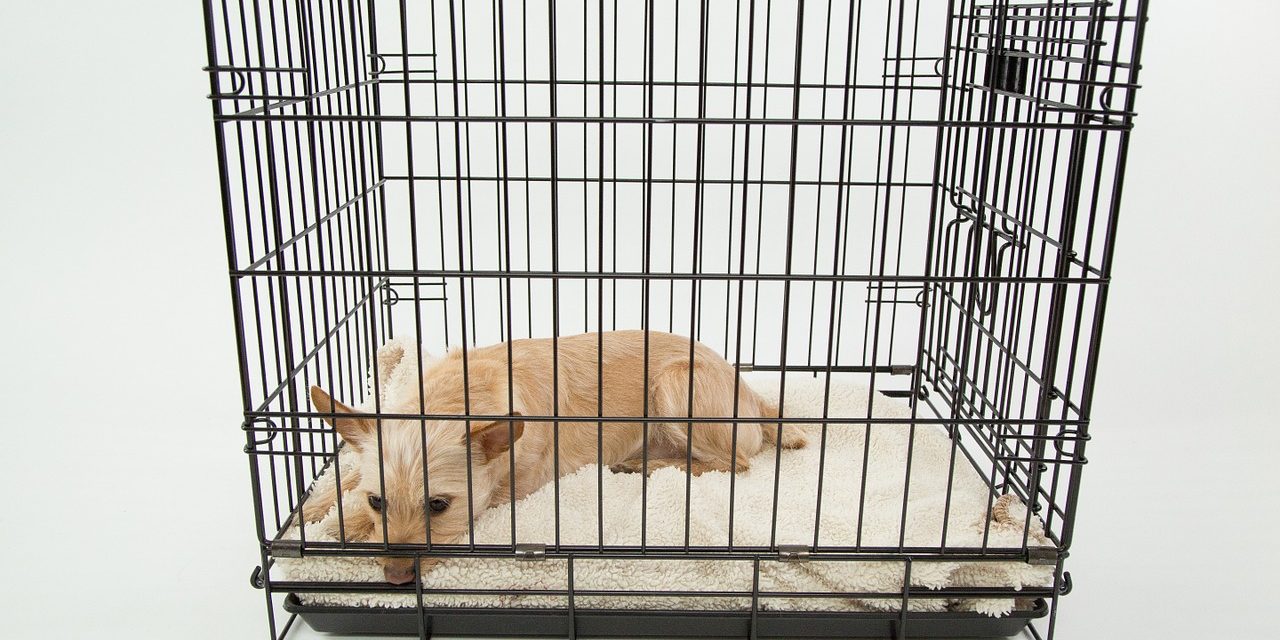For those who don’t know, crate training is the process of teaching your dog to associate being in a crate as a familiar and safe environment. Crate training is very popular amongst pet owners and it is often recommended by experts and leading organisations.
Crate training is a great way to create a safe space for your dog to eat, sleep or rest, depending on how you intend to use them. An important thing to note is that crates are not used as a form of punishment. You can crate train both puppies and adult dogs, but it would be easier for a puppy to learn than it would be for an older dog. The use of crates can either be a temporary or permanent part of their routine.
The length of time that it takes to successfully crate train your dog will depend on their age, the breed, temperament, and past experiences. One tip for crate training is to go at a slow pace, ensuring that you aren’t moving too quickly and being careful not to overwhelm your dog. Another helpful tip is to make sure that the crate remains a positive environment and avoid associating the space with any negative consequence.
What to expect from our article
Choosing the Perfect Crate
The first thing to consider once you’ve decided to crate train is what crate you are going to use. There are a variety to choose from both online or in pet stores. The crate that you use needs to be big enough for your dog to sit, stand up and easily turn around in. If they can’t, then the crate is too small. They also need to be able to lie down with enough space.
If you are planning to use crate training as a secure space for your dog to sleep in overnight, then there needs to be room for a water bowl. There are specific products that you can buy that are really useful for crate training. AMAZON AFFILIATE. Another thing to consider is if you are going to use bedding in the crate, if so, then it needs to be able to have room for it.
Crates come made of different materials, but the most commonly used is metal, as they are often collapsible and they create a stable environment.
You should also think about where you are going to put the crate before purchasing, so you can measure the space and make sure there’s enough room for it.
Starting Crate Training
Once you have chosen and set up your crate, the only thing left to do is to start your training. Some dogs may be curious and investigate the crate without prompting, but others may need some extra encouragement. Try to encourage your dog to come over to the crate.
You can use treats as a way to get them to come closer. It is important to note that you shouldn’t force them to go inside if they aren’t ready, as you don’t want them to be scared of going inside. Make sure the door of the crate is widely open and isn’t going to slam shut and frighten them
As they gain confidence being near the crate, try moving the treats closer to the door, and eventually inside. This step could take minutes, or with more weary dogs it can take longer. Make sure to use lots of praise when your dog is completing these steps to keep up the positive association and let them know they’re doing a good job. Once they are happy to go in and out of the crate, you can move on to the next step.
Mealtime and Closing the Door
Once the introduction stage is over, and your dog seems confident enough to go in and out of the crate as they please, you can begin to feed them their meals inside the crate. Spending mealtimes in the crate will help them associate being in the crate with a positive reward.
When they are eating their meals in the crate without hesitation, you can try to introduce the next step, which is closing the door behind them. If your dog is particularly anxious, you can start by slightly closing the door before closing it fully. Otherwise, you can start by closing the door when they begin eating and opening it again when they have finished eating.
Over time, you can work your way up to leaving the door closed for longer periods. This will get them used to being in the crate with the door closed, without progressing faster than they are comfortable with.
After some practice, your dog should be completely comfortable to remain in their crate with the door closed for longer periods of time. If they begin to get uncomfortable at any point, you can repeat the previous steps again to work on their confidence.
Leaving the Room
Once they are happy to be in the crate with the door shut you can then try and get on with other tasks around the room or even try to leave the room completely. At first, this may be easier to do whilst they are busy eating. Try to do this gradually and make sure that your dog isn’t getting stressed.
Once this stage is successfully complete, if you want to use the crate for anything other than meal time, (such as overnight stays etc), you can start to disassociate being in the crate with mealtimes and food. Your dog should have learnt the behaviour by this point, and will now know what they are supposed to be doing when you use certain command words and gestures near the crate. Try getting them to be comfortable in the crate without the incentive of mealtimes. Start with shorter periods of time, and work your way up to longer periods of time, just like before.
Different Uses for Crates
Crates can be used for different reasons. Some of these include:
- Eating meals
- Sleeping in overnight
- To stay in whilst you’re not at home
- A place to calm down
- Travelling
Now that your dog is crate trained, you can put their training to use. Crates can be used as a safe space to leave your dog at home when you go out if they are particularly troublesome when alone. It may be beneficial to leave them a toy to play with or a puzzle feeder for if they get bored.
Crates can also be used to help to train your dog, as it aids in giving them a consistent routine. If you are planning to use the crate for sleeping in, make sure to be consistent and use this method often, so it doesn’t become confusing and they know what to expect at night time.
Whilst crates should never be used as a form of punishment, they can be used as a ‘time out’ space if they get over excited. They can stay in the crate until they have calmed down.









Trackbacks/Pingbacks